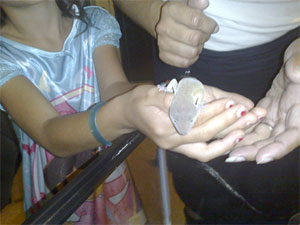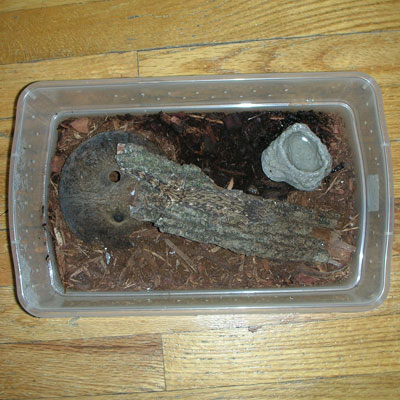This month’s Readers’ Questions focus on aspects of helping a recently acquired or young gecko settle in to its new environment. Although some of the details may be specific to the species in question, there are many general principles that will apply to any new reptile acquisition.
[ad#sponsor]
Question 1:
This question is about socializing my gecko and getting her to be alright with being handled by people. Every time I try to handle her, she bites me. All I do is place my hand, palm up and slanted, about 6 inches from her, and she proceeds cautiously towards my hand and then bites me. My friends’ girlfriend bought her two geckos from the same place at the expo and hers are more than willing to be handled. Tonight she tried to handle my gecko (Havana) and she bit her as well. Mine just seems so either aggresive and/or scared and she just doesn’t trust me or anyone else. I want nothing more than her well-being as well as her being comfortable in her surroundings as well as with people. If you can offer any advice as a gecko veteran, I’d appreciate it.
Aliza Arzt responds: I’m sorry you’re having such a hard time. I have had some geckos that approach me and bite me all the time, but the only reason for that is the geckos are used to being hand fed and think they’re going to get a worm every time they see a finger. I used to joke that these geckos thought my fingers were the worm dispenser and they had to “press the button” to get one.

So, I have two suggestions: first, feed the gecko till she seems full. If she’s not eating for you yet, try holding a mealworm or a cricket by one leg out for her and I wouldn’t be surprised if she takes it from you. This is both good and bad. On the one hand, she’ll come to associate your hand with food, on the other hand, she’ll come to associate your hand with food and bite you, so if she’s eating on her own, just feed her until she doesn’t want more.
Then, try to scoop her up from behind by sliding your hand under her body and immediately make a little cave out of one hand and cover the “cave” with your other hand. Hopefully she’ll sit in there for awhile. Give her a short time and put her back before she can get upset. If she wants to move, use your hands to let her walk from hand to hand. Try to avoid grabbing her around the middle because it will upset her. If she bites you, you’re no worse off than before.
Khrysty Gonzalez responds: Geckos come with different personalities and each one needs to be worked with at its own pace. Sounds to me like your gecko is just scared. Let her get used to you first, before you try and socialize her with other giant humans. Most creatures aren’t comfortable with huge unknown things coming toward them from the sky, and they tend to get defensive. So when your hand settles at the bottom of her cage, she’s ready to attack. Are you pulling away very quickly when she bites? If you do, that’s encouraging the behavior. She’s led to believe that a bite will make the big thing, the possible “predator,” go away. Stay calm, and stick with it. If you don’t flinch or pull away, and just let her bite you, she’ll soon learn that this behavior isn’t working any more.
Once she stops trying to attack, she’ll start to explore your hand. Eventually she’ll come to see that you’re not a threat and start spending more time on your hand (you’re pretty warm, after all, and geckos definitely appreciate the warmth). After she’s been comfortably exploring, or even settling on your hand for a few days, try lifting your hand up a bit and holding it there. Take it in baby steps so as not to scare her. I know it’s tedious, but it is necessary. Eventually, she will come to trust you. And once she does, and you’re sure she’s comfortable with you, you can go ahead and let other people handle her. She shouldn’t react any differently with them than she does you
[ad#sponsor]
Question 2:
What’s the best way to introduce a gecko (R. leachianus) into a new environment without incurring undo stress?
Matthew Parks responds: The best way to introduce any new gecko into a new environment is to make sure that the enclosure is set up properly, taking into account the specific needs of the particular gecko. For a leachie, you will want to make sure you have the basics down first. Cage size, temperature and humidity, and plenty of cover. Cage size will depend on the age of the animal. Smaller cages for hatchlings and young juvies, and increasingly larger cages as they grow. Temperatures should range from around 70 to 78 degrees, and humidity should be around 60% with brief periods of 90% + humidity. Probably one of the most important stress reducers is making sure there are places to hide. Leachies like to curl up in cork tubes or other similar structures. Cork tubes and flats can be utilized throughout the enclosure for hiding and for use as climbing structures. Lastly, you need to allow your leachie plenty of time to acclimate to the new enclosure before you do any kind of handling. Give your leachie at least two weeks to get used to things, and after that keep handling time to a minimum, maybe 10 minutes per day or so.
[ad#sponsor]
Question 3:
I recently acquired my dream baby Leachianus Gecko.I am looking for advice on getting him settled and growing. He does eat some, but there isn’t much poop in the cage, and although it’s hard to tell with soft food if it has been consumed; often it doesn’t look like he touched it. When I give him crickets he eats a few, and then keeps the rest as pets, LOL. I have had him since 2/28/2010 and he has yet to shed.Any advice you could offer to make him more comfortable would be greatly appreciated. I absolutely adore him, and want to do anything I can to help him along.
Matthew Parks responds: It sounds like your gecko is eating, just not eating as much as you think he/she should. Some leachies really enjoy crickets and others do not. Hatchling to juvie leachies can handle a decent size cricket of 1/2″ to 3/4″ or so, and will often ignore smaller insects. When feeding any type of insect, make sure you are dusting and gutloading them prior to offering them to your gecko. Doing so will make the feeder insects much more nutritious and balanced. You can try some other types of insects such as appropriately sized feeder roaches to see if the gecko prefers them.
You should also offer a good food like Repashy Gecko Diet. My Leachies prefer the 2 part diet with real papaya as the flavor portion. Some leachies are picky so spend some time playing around with the different flavor options, and also with figuring out how thick or thin they like the diet mixed up.
I hope that answers your questions.
Steve Cemelli responds to both leachianus questions: The best way to see if your leachie is eating is to use a substrate, such as paper towels where you can see how much he’s pooped. If he’s a hatchling, offer crickets once a week, making sure not to put so many in that they will bother the gecko. Make sure your animal doesn’t eat just crickets. It is important to offer him a high quality diet like Rapashy’s Crested Geckio Diet (CGD) 2-3 times a week and to only offer your crickets 1-2 times a week. This way he’ll be hungry and more apt to try the CGD. It is important to place the CGD in a deep enough cup so that he cannot walk through it. Only a small amount should be offered so you can tell if he’s eaten or not. Special care should be taken to maintain a high humidity between 60 and 80% and temperatures in the mid to upper 70’s. A baby leachie kept too dry may not find or eat his food. It is important for him to have both a moist area and a dry area in the cage. I use shoebox enclosures and I have a water dish on one side (see photo) which I overflow in one corner. if your animal still does not seem to be eating, you may want to try a smaller enclosure. You didn’t state the size of your animal but if it is under 30 grams it should still be in something like a shoebox enclosure (see photo). Housing a young gecko in too large an enclosure can sometimes make it go off food.
About Our Experts
Aliza Arzt is one of Gecko Time’s editors. In her other life she is a home care speech therapist living in the Boston area. She has been breeding leopard geckos since 2005 and has recently been successful in breeding African Fat Tail and Coleonyx geckos as well. Other interests which she pursues in her copious free time include work in ceramics, practicing aikido and surfing the internet. Her live and ceramic geckos can be found at http://geckcessories.wordpress.com
Steve Cemelli is the owner of Leapin Leachies. He has kept reptiles and amphibians for over 30 years including all of the different species of Rhacodactylus and maintains one of the largest locale specific collections of R. leachianus in herpetoculture today.
Khrysty Gonzalez has been taking care of reptiles since she was 13 years old, but has really gotten into leopard geckos in more recent years. She currently owns ten of them, and cares for three more on a regular basis. Six of the animals came from pet stores as juveniles and had to be properly socialized. Two she’s had from hatchlings, and the rest came from breeders and were already people-friendly when they arrived. http://khrystys-kritters.webs.com/
Matthew Parks is the owner of Pangea Reptile (www.pangeareptile.com) and breeder of Rhacodactylus Geckos.



Thank you so much. I am actually doing just about all of that. The Repashy food at the local pet store is only one flavor though, and it is banana. I will try to hunt down some of the papaya.
He does sort of outsmart the paper towel trick by mostly pooping on his plants, but I’m getting better at finding it.
He does appear to be getting more comfortable with his surroundings, and growing a little. I’m certain most of my concerns are an overactive mama gene, but I hugely appreciate the advice, and will modify things to be SURE he’s comfortable.
I have wanted a Leachie since I knew of their existance, but having access to people who have experience with them, makes this an even better time to have actually gotten one. Thank you again :o).